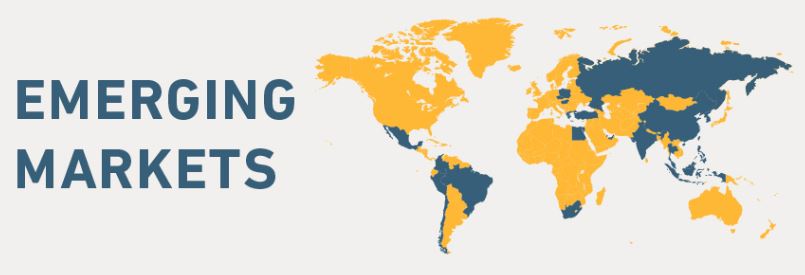Emerging Markets
The contemporary world economy gets its support from the phenomenon of the emerging markets and its consequential development of emerging markets multinationals (MNCs) (Sinkovics, et al. 167). The new re-engineering of the modern economic and political order is as a result of the state of international emerging markets that is much conspicuous in the recent past. According to the international business, the term emerging markets get referred to nations that are in constant motion and also have the capability of gaining a significant economic and political power (Cavusgil, Tamer, et al. 40).
The emerging economies showed the ability to endure a recession that bypasses even the major economies during the Financial Crisis that the world faced at the primary stages of the new millennium. They include the best emerging 20 (E20) countries selected based on their recorded GDP, the population, and the overall influence on both regional and international trade (Cavusgil, Tamer, et al. 46). For example, the E20 consists of Brazil, Chile, China, Argentine, Poland, Colombia, Saudi Arabia, South Africa, Malaysia, Mexico, Thailand, Russia, Philippines, Republic of Korea, South Africa, Turkey, Indonesia, India, Nigeria, and Iran. This report aims at examining the emerging markets from the E20’s enhanced economic growth, the ever-growing influence across the world economies, and increased technological advancements.
Emerging Markets and Economic Growth
The E20 savings are known to be dominated by a substantial and rapidly growing number of people. According to world census conducted recently, emerging markets population account for 50% of the total four billion estimated world population. For example, in a comparative perspective, 18% of the world’s population stays in OECD nations; an approximated 11% lives across the G7 countries which also recorded yearly population growth of a rate of 0.0051 of the total population (Cuervo-Cazurra, Alvaro, and Ravi Ramamurti 230). On the hand, E20 nations are also prone to an increase in annual population by 0.01 (Sinkovics, et al. 169).
Also, demographically, emerging markets consist of a community of the young generation who are at their prime ages. Even though the youths are demanding regarding the money allocated to the education and higher learning institutions, they act like a source of wealth to a country. For example, a learned young generation provides skilled and advanced technical know-how to their economy, the source of cheap labor to the available industries, and a potential market for the ready manufactured goods and services. Conversely, in the United States, Japan, and Europe the majority comprises of working age population.
A nation with working age as the majority is at crossroads since the working age has the capability of ether impact the economy positively or negative (Cuervo-Cazurra, Alvaro, and Ravi Ramamurti 230). For instance, a country with a majority of working age must have implemented a beneficial education and healthcare system because the working class is aging very fast and the possibility of an increased dependency ratio. However, some of the E20 countries showcased an age structure that consists of a rapidly aging population such as China and Korea. Nevertheless, E20 states still well placed to have a productive working force that other developed economies (Cuervo, Alvaro, and Ravi 230).
Integration into the international Markets
With the high population in E20 countries, there are readily available markets for the produced goods and services (Hill, Charles, et al. 77). According to world consumer research conducted in 2010, the United States and Europe take the lead in the world consumer market. However, there is the likelihood that Asia will overtake them by 2030 due to rapidly growing emerging economies. The recent paradigm shift indicates how emerging economies are gaining firm ground across the international market arenas.
E20 countries learned a lot of world market influence between the early year 2000 and 2015 by a margin increase of approximately 6%. However, E20 nations have suffered currency volatility for not less than twenty years, which was worth declared a crisis among them. For example, Mexico, Asia, Russia, Argentina, and Brazil were the witnessed victims in the late 1990s. Fortunately, the emerging markets with the firm ground established in the contemporary international economy have the upper hand to maintain their positions (Hill, Charles, et al. 79).
Furthermore, the emerging markets have increased their total exports to the world markets averagely 20% and that some countries stand as major commodities exporters. Emerging countries are the majority of the states with the most significant manufacturing products applying the advanced technology. For instance, China, Korea, and Malaysia use the highest technology in manufacturing their exports and that they also enjoy the lion’s share of FDI, therefore raising their international investments. The economic growth resulted in a well-consolidated world economy that boosted technology and innovation knowledge (Brannen, Rebecca and Susanne 141).
Technological Advancement in Emerging Markets
Growth and development of a nation must get measured by the level of technology and innovation present. Initially, high technology and innovation was only a reserve for the developed countries. However, in the current days, emerging economies have concentrated their efforts to improve their technological know-how through boosting research and development sector by providing resources and human capacity by embracing the right education system (Hill, Charles, et al. 79). For instance, innovation improvements have greatly addressed the local problems to match the general atmospheres in the already developed countries.
Innovative cultures in emerging economies contributed to the development of new technology in the banking industry, telecommunication, and to the overall savings which not only benefited the locals but also spread to the rest of the world (Peng, Mike, and Sergey 12). Therefore, the emerging markets end up pioneers of some world innovations and technological advancements.

The E20 countries paid much attention in research and development funding both public and private sectors of the economy. Research and development are significant indicators of technology and innovation in any economy of the world (Peng, Mike, and Sergey 19). For instance, Korea and China are the leading nations which took more significant strides in R&D followed by Turkey and Malaysia.
Moreover, the emerging economies witnessed to embrace the right education system that promote innovative talents and that they use the most significant art of public expenditure on education. For example, Argentina, Mexico, South Africa, Malaysia, and Brazil were among the emerging nations with the highest education allocation. The E20 countries take education seriously since it is the critical factor that influences the full and sustainable economic growth.
Globalization
The emergence of interconnectivity of world nations through cooperation laid a firm ground for the emerging economies (Brannen, Rebecca and Susanne 139). The world’s economic and political order experienced a paradigm shift where countries were aiming to form multilateral cooperation resulting into formation of world developmental institutions like development bank and Asian Infrastructure Investment Bank and International Monetary Fund. The establishment of the last global institutions facilitated the emerging market’s contribution in global affairs, international trade, and investment (Brannen, Rebecca and Susanne 141).
Conclusion
The emerging economies managed to transform the global economy by constant and robust economic growth and the trend seeming to continue because of some reasons identified by this report. First, the emerging economies have both principal actors and regional powers than developed nations. Second, the majority of the emerging markets anchored the economic development on the right pillars such as technology and innovation.
Finally, these emerging economies enjoyed the current world readiness for international cooperation. Despite the possible challenges that particular emerging economy shall experience, there rise in general marked a milestone in the global landscape.
Work Cited
Brannen, Mary Yoko, Rebecca Piekkari, and Susanne Tietze. “The multifaceted role of language in international business: Unpacking the forms, functions and features of a critical challenge to MNC theory and performance.” Language in International Business. Palgrave Macmillan, Cham, 2017. 139-162.
Cavusgil, S. Tamer, et al. International business. Pearson Australia, 2014.
Cuervo-Cazurra, Alvaro, and Ravi Ramamurti, eds. Understanding multinationals from emerging markets. Cambridge University Press, 2014.
Hill, Charles, et al. Global Business Today Asia-Pacific Perspective. McGraw-Hill Education, 2017.
Peng, Mike W., and Sergey Lebedev. “Intra-national business (IB).” (2017): 241-245.
Sinkovics, Rudolf R., et al. “Rising powers from emerging markets? The changing face of international business.” 0969-5931 23.4 (2014): 675-679.
Relevant Posts
Emerging Markets FDI China Dissertation
International Business Dissertations
Did you find any useful knowledge relating to international business and emerging markets in this post? What are the key facts that grabbed your attention? Let us know in the comments. Thank you.




